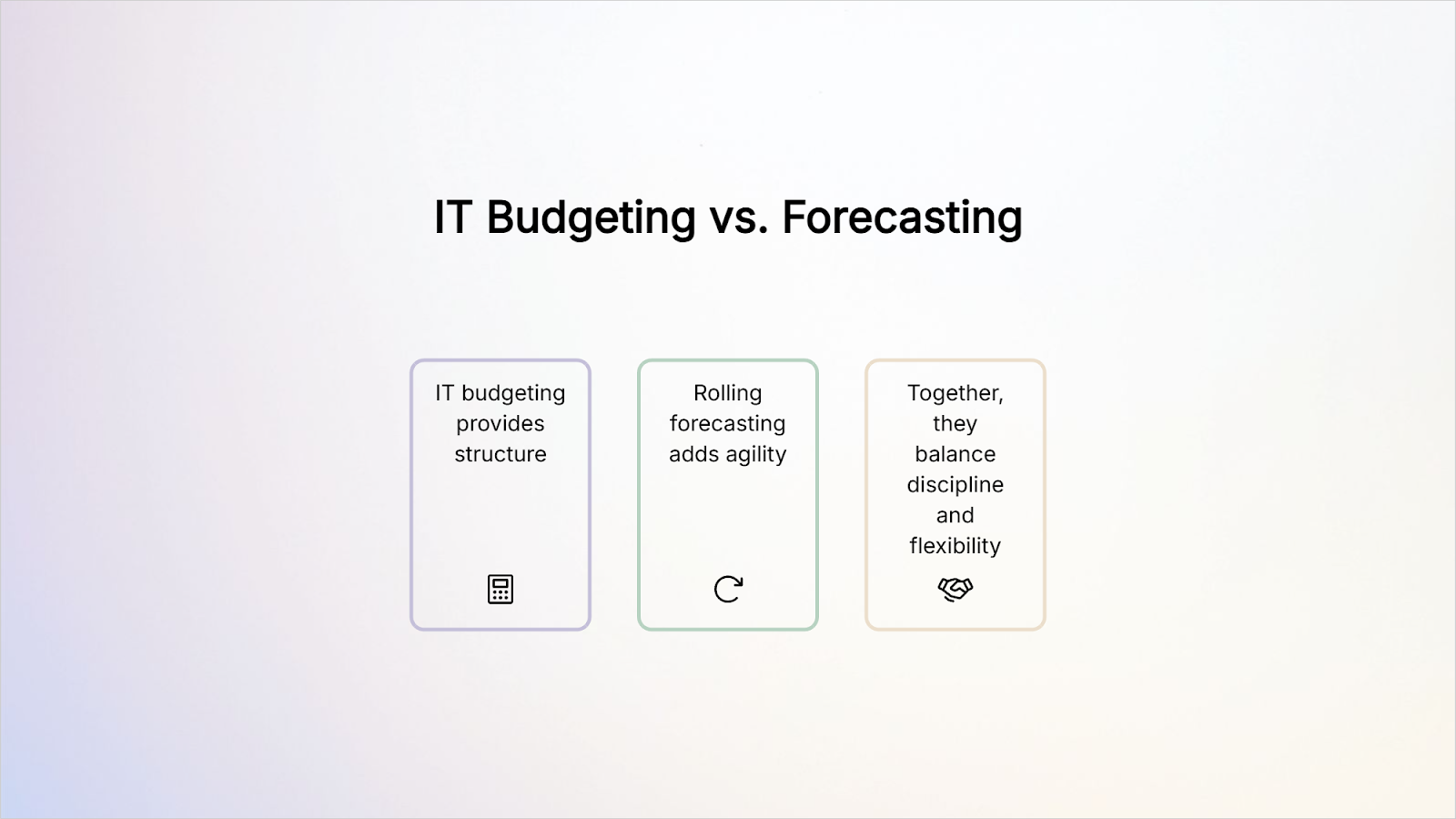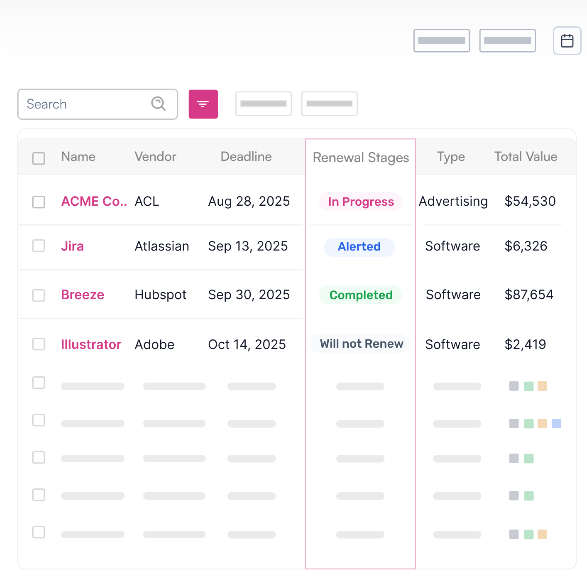

IT Budgeting Best Practices for Businesses

IT Budgeting Best Practices for Businesses
Discover IT budgeting best practices to control costs, align technology with business strategy, and plan for sustainable, growth-driven IT spend.


By 2027, more than half of enterprise IT spending will move to cloud services, shifting budgets away from predictable hardware costs and toward variable, usage-based billing. For CFOs, CIOs, and procurement leaders, this transformation raises the stakes. Traditional budgeting models built around fixed costs no longer apply, and uncontrolled SaaS renewals or cloud overruns can quickly erode margins.
Strategic IT budgeting provides the structure needed to navigate this shift. With the right practices, businesses gain visibility, improve accountability, and align technology investments with long-term growth. Instead of chasing overruns, leadership can proactively plan, optimize contracts, and ensure every dollar in IT spend delivers measurable value.
What Is IT Budgeting?
IT budgeting plans, allocates, and tracks technology spend so it supports company goals. It covers all costs, funds innovation, and sets a small contingency. Teams prioritize projects, use past data, monitor and adjust quarterly, involve stakeholders, stay flexible, consider outsourcing, and balance cost, value, and risk.
IT Budgeting vs. Forecasting

While often used interchangeably, IT budgeting and forecasting serve distinct purposes in IT governance policies and financial planning.
- IT budgeting provides structure: It defines allocation across categories such as cloud infrastructure, information security, software systems, and IT support. This ensures predictability in the IT cost structures.
- Rolling forecasting adds agility: Forecasts are revised to reflect actual IT expenses, unplanned projects, or emerging investment needs. This is especially critical for fast-changing areas like cloud subscriptions, data security, or disaster recovery.
- Together, they balance discipline and flexibility. Without either, IT cost structures can become too rigid or volatile, hindering alignment with business objectives.
7 Best Practices for IT Budgeting

1. Separate CapEx and OpEx
CapEx covers long term investments such as data center upgrades and major hardware refresh. OpEx covers subscriptions, support, cloud, and staffing. Splitting them makes cash planning and depreciation simple for finance. It also shows what keeps the lights on versus what expands capacity.
With a clean split, SaaS and cloud trends are easier to track and explain. You can stage CapEx by quarter and smooth OpEx with usage caps. Spendflo helps by tying SaaS and renewal timing to the right bucket. Approvals move faster because the story is clear.
2. Centralize vendor and contract data
Move contracts, quotes, invoices, and renewal dates into one system with named owners. Spreadsheets and inboxes hide deadlines and create version fights. A single view stops missed renewals and surprise increases. Finance gets a clear map of committed spend.
Put reminders well ahead of end dates and attach usage data to each vendor. You can compare options, set price targets, and avoid last minute scrambles. Spendflo adds renewal calendars and usage insights so decisions are quick. The result is fewer errors and stronger terms.
3. Use real usage analytics
Measure active seats, feature adoption, storage growth, and compute hours. Compare what teams use against what you pay. Right size before renewals and retire duplicates in crowded categories. Savings appear without slowing work.
Keep an eye on leading signals so small drifts do not become large gaps. Share a simple scorecard so owners know where to act. Spendflo surfaces idle licenses and overlapping apps in one place. Budgets stay aligned with reality rather than guesses.
4. Involve stakeholders early
Bring finance, procurement, security, and business leads into planning. Confirm goals, risks, and success measures so tradeoffs are clear. Early input reduces pushback later and speeds approvals. Each major line should have an owner.
Use short intake forms to capture headcount plans, license tiers, and timelines. Map requests to outcomes like revenue, uptime, or compliance. Spendflo keeps these asks tied to vendors and dates. Everyone works from the same facts.
5. Review and update quarterly
A plan set in January will drift by spring. Run a quarterly check against actuals and adjust for hiring, vendor prices, and new rules. Move money from low adoption tools to projects that are working. Document what changed and why.
Set a monthly rhythm for variance reviews and a deeper refresh each quarter. This steady cadence keeps leaders confident and avoids fire drills. Spendflo provides live renewal and usage data for these meetings. Decisions get made in one pass.
6. Build a contingency fund
Hold five to ten percent for surprises such as security fixes, audits, or cloud spikes. Define who can use the buffer and under what conditions. Track every draw and plan how to repay it. Priority work keeps moving even when something breaks.
Pair the buffer with a small list of deferrable items. If spend runs hot you know what to pause first. Spendflo alerts you to unusual usage so you act early. The cushion prevents rushed buys at bad terms.
7. Use benchmarks and market data
Know the price bands and discount tiers for your main categories. Compare unit costs and terms to current market levels before talks begin. Ask vendors to match credible benchmarks or improve commitments. Negotiations start from facts, not hope.
Keep your benchmarks next to usage and renewal dates. You can time multi vendor bids and set firm targets. Spendflo combines pricing intel with live utilization so you land cleaner deals. Over time your effective price trends down while value goes up.
Steps in the IT Budgeting Process

Following a structured process ensures that best practices are consistently applied. Typical steps include:
1. Evaluate current expenditure
Pull a full-year view of invoices, contracts, and usage, then line it up by vendor and category. Match what you paid to what teams actually used so idle licenses, duplicate tools, and price creep stand out. Create a renewal calendar and tag auto-renew clauses to avoid surprises.
Turn these findings into a baseline with clear owners and quick wins. Identify savings from right sizing and co-termination and note any gaps in security or compliance. If you use Spendflo, link spend to live usage so the baseline reflects reality. Start the new plan with numbers everyone trusts.
2. Gather requirements
Meet department heads and IT leads to capture needs early, from license counts to cloud capacity and support levels. Use a short intake form that asks for headcount plans, timing, and success measures. Convert each ask into units you can price, such as seats, storage, or API calls.
Be sure to document dependencies such as integrations and data migration to avoid unexpected costs down the line. Assign an owner to every request which makes follow-ups much easier. In tools like Spendflo, connect requests to vendors and renewal dates. Having early clarity helps prevent surprises later in the year and makes approvals smoother.
3. Prioritize goals
Rank requests against business strategy, risk, and timing. Give weight to revenue, uptime, security, and compliance, then park nice-to-haves in a pilot lane. Write down the tradeoffs so everyone understands what moved and why.
Review this ranking with finance and product to lock alignment. When plans change, update the list and note the shift. A clear priority path makes it easier to defend choices in executive reviews. It also keeps budget cuts from hitting critical services.
4. Estimate costs
Gather vendor quotes and compare tiers with market benchmarks so you know a fair range. Include one time fees, implementation, training, taxes, and required add ons like SSO or audit logs. Model usage for cloud and AI so variable costs do not blow the plan.
Add expected give backs from right sizing and duplicate removal. Keep a record of assumptions so you can explain variances later. With Spendflo, bring in historical prices and discount bands to set targets. Better estimates mean fewer reroutes during the year.
5. Allocate resources
Split the plan into CapEx for big upgrades and OpEx for day to day services. Fund lights on items first, then stage growth projects by quarter to smooth cash needs. Map each line to an owner, a KPI, and a renewal month so handoffs are clear.
Publish a simple vendor calendar so leaders see what is coming. Define a short intake for new tools that includes security and budget impact. In Spendflo, you can view category totals and drill into contracts in one place. Clear allocation keeps execution steady.
6. Review and approve
Package the draft in a clean deck or dashboard that shows costs, value, and risks. Include a one page summary, category roll ups, and the renewal timeline. Call out savings assumptions and any dependencies across teams.
Set a quarterly check in so updates are expected, not ad hoc. Confirm owners and next steps before you leave the room. When the story is simple and the data is solid, approvals move faster. Shared visibility builds trust with executives and boards.
7. Track and adjust
Compare actuals to plan each month and highlight deltas by vendor and category. Watch early signals like active seats, feature adoption, storage growth, and cloud credits. Retire shelfware, cap usage where possible, and reopen talks if terms drift.
Run a deeper refresh each quarter and reforecast as hiring, projects, or rules change. Move funds from low adoption tools to higher impact work with a short approval path. Spendflo helps by surfacing usage and renewal risks in one view. Small monthly fixes prevent big year end gaps.
How Spendflo Helps With IT Budgeting

Many organizations continue to lose control of IT budgets, overspending on unused licenses, missing renewals, and relying on spreadsheets that fail to provide accurate visibility. One of our clients, a mid-market SaaS company, uncovered $375K in hidden software waste within the first quarter of using Spendflo.
The reality is clear: without automation and real-time data, finance and IT teams will always be stuck reacting to problems instead of planning ahead. Budgets spiral, compliance risks increase, and decision-makers struggle to prove ROI.
Spendflo changes this. With centralized vendor data, automated renewals, real-time utilization checks, and benchmark-backed negotiations, we help companies cut software costs by up to 30% annually all while turning IT budgeting into a predictable, ROI-focused process.
Ready to bring discipline and intelligence into your IT budgeting? Book a demo with Spendflo today.
Frequently Asked Questions
1. What are IT budgeting best practices?
These are tested procedures including attempting to separate CapEx and OpEx, consolidating vendor information, applying usage analytics, and engaging stakeholders to make better and effective budgets.
2. Why is stakeholder involvement important in IT budgeting?
It also makes the budget capture the real needs of the business and create a sense of accountability between departments, which increases chances of the budget being honored.
3. How often should IT budgets be reviewed?
Quarterly reviews are ideal. They maintain budgets in accordance to the fluctuating prices of vendors, requirements of the project, and business priorities.
4. How does forecasting differ from budgeting?
Budgeting is a plan of the year and forecasting is a modification of the plan to the changing real-life conditions. The two are required in order to strike a balance between discipline and flexibility.
5. How does Spendflo support IT budgeting best practices?
Under Spendflo, contracts are concentrated, usage is monitored, benchmark pricing is offered and the renewal procedures are also automated so the IT budgets have become more accurate and simple to handle.










.png)




.png)




%20Questions%20to%20Ask%20Vendors.webp)





.avif)





